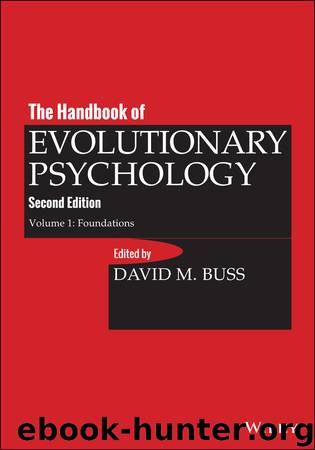The Handbook of Evolutionary Psychology, Volume 1 by Buss David M

Author:Buss, David M.
Language: eng
Format: epub
ISBN: 9781118755884
Publisher: John Wiley & Sons, Inc.
Published: 2015-10-26T00:00:00+00:00
Sources of Variation in Attractiveness Assessment
Adaptations for attraction and disgust are expected to be facultative within reaction norms. We expect them to be sensitive to the cost–benefit structure of their bearer's current circumstances and phenotypic condition, and also to the local conditions under which they develop. For social relationships, we expect these mechanisms to be sensitive to the kind of relationship (e.g., mating, trading, alloparental) for which an individual is being assessed. Evolutionary life history theory (LHT) points to age- and context-related trade-offs that were likely at play in the evolution of attractiveness-assessment mechanisms. Thus, with insights derived from the study of small-scale societies, LHT provides a framework for generating predictions about why and how the operation of attractiveness-assessment mechanisms varies under different circumstances.
Because success in the human ecological niche depends on multiple social relationships, the first prediction suggested by LHT is that attractiveness assessment will vary depending on the social value being assessed. A second source of variation in attractiveness assessments is the phenotypic state of the assessor, including the individual's sex, developmental stage, and reproductive state. For example, female assessments of male sexual attractiveness vary across the ovulatory cycle, and assessments of others' sexual attractiveness are affected by the assessor's relative sexual attractiveness as a short- or long-term mate. Individuals also vary in their socio-sexual orientation, or the degree to which they desire, approve of, and engage in committed versus uncommitted sexual relations, and this too can affect the relative attractiveness of different traits (Penke & Asendorpf, 2008; Simpson & Gangestad, 1992). Disentangling the effects of genetic variation on phenotypic state is critical here, as some kinds of variation are more relevant than others to explaining why different assessors find different individuals attractive. For example, the major histocompatibility complex (MHC), a gene complex involved in immune function may affect sexual “chemistry” between individuals.
Variation in reproductive and sexual strategies provides a third basis for variation in assessments of sexual attractiveness, and this same principle should apply to other strategies and social values. Consider cooperation: When there are physical cues associated with differences in cooperative strategies, individuals exhibiting different cues should be more or less attractive depending on the cooperative strategy of the assessor. For instance, an individual deploying a hawk strategy should find individuals exhibiting cues associated with a dove strategy more attractive as potential prey than individuals exhibiting cues associated with a hawk strategy.
Another source of variation in attractiveness assessments is local differences in the range of available variation in the cues being assessed (Sugiyama, 2005). This principle should hold regardless of the social value(s) being assessed, because attractiveness for any social value is relative to the available alternatives within a particular context. Research suggests that some of the available range of variation is based not only on local variation in the cues being assessed but on the phenotypic condition of the assessor.
In mating, another source of assessment variation is the range of competitors and the relative competitiveness of the assessor. The costs and benefits of different strategies
Download
This site does not store any files on its server. We only index and link to content provided by other sites. Please contact the content providers to delete copyright contents if any and email us, we'll remove relevant links or contents immediately.
Rewire Your Anxious Brain by Catherine M. Pittman(18589)
Talking to Strangers by Malcolm Gladwell(13291)
The Art of Thinking Clearly by Rolf Dobelli(10324)
Mindhunter: Inside the FBI's Elite Serial Crime Unit by John E. Douglas & Mark Olshaker(9263)
Becoming Supernatural by Dr. Joe Dispenza(8167)
Change Your Questions, Change Your Life by Marilee Adams(7684)
Nudge - Improving Decisions about Health, Wealth, and Happiness by Thaler Sunstein(7657)
The Road Less Traveled by M. Scott Peck(7555)
The Lost Art of Listening by Michael P. Nichols(7453)
Mastermind: How to Think Like Sherlock Holmes by Maria Konnikova(7278)
Enlightenment Now: The Case for Reason, Science, Humanism, and Progress by Steven Pinker(7273)
Win Bigly by Scott Adams(7139)
The Way of Zen by Alan W. Watts(6553)
Daring Greatly by Brene Brown(6473)
Big Magic: Creative Living Beyond Fear by Elizabeth Gilbert(5677)
Grit by Angela Duckworth(5555)
Ego Is the Enemy by Ryan Holiday(5347)
Men In Love by Nancy Friday(5192)
The Laws of Human Nature by Robert Greene(5080)
